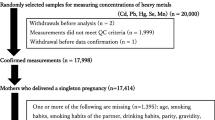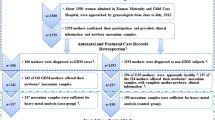Abstract
Purpose
To examine the association between elevated blood cadmium (Cd) and lead (Pb) concentrations and increased risk of gestational diabetes mellitus (GDM).
Methods
This cross-sectional study included pregnant women (n = 16,955) enrolled in the Japan Environment and Children’s Study. Concentrations of Cd and Pb in blood samples collected at 22–28 weeks’ gestation were measured by inductively coupled plasma mass spectrometry. GDM was diagnosed according to the 2011 Japan Society of Obstetrics and Gynecology and Japan Association of Obstetricians and Gynecologists criteria. Adjusted odds ratios (OR) and 95% confidence intervals (CI) were estimated using logistic regression analysis.
Results
Blood Cd and Pb concentrations were slightly higher among women with GDM than among those without GDM; however, these differences were not statistically significant. Elevated blood Cd and Pb concentrations were not associated with increased GDM risk in the nulliparous group (Cd OR 0.76; 95% CI 0.28–2.08 for high vs low category; Pb OR 2.51; 95% CI 0.72–8.72) or the parous group (Cd OR 0.64; 95% CI 0.29–1.44; Pb OR 0.31; 95% CI 0.04–2.29).
Conclusions
This study demonstrates that Cd and Pb exposure, in the range of blood levels observed, has no significant relationship with the development of GDM. Further prospective studies would be valuable to confirm these findings.

Similar content being viewed by others
References
Adams SV, Newcomb PA, Shafer MM, Atkinson C, Bowles EJA, Newton KM et al (2011) Sources of cadmium exposure among healthy premenopausal women. Sci Total Environ 409(9):1632–1637
Afridi HI, Tasneem GK, Kazi N, Jamali MK, Arain MB, Jalbani N et al (2008) Evaluation of status of toxic metals in biological samples of diabetes mellitus patients. Diabetes Res Clin Pract 80(2):280–288
Barregard L, Bergström G, Fagerberg B (2013) Cadmium exposure in relation to insulin production, insulin sensitivity and type 2 diabetes: a cross-sectional and prospective study in women. Environ Res 121:104–109
Borné Y, Fagerberg B, Persson M, Sallsten G, Forsgard N, Hedblad B et al (2014) Cadmium exposure and incidence of diabetes mellitus-results from the Malmö Diet and Cancer study. PLoS One 9(11):e112277
Bryson CL, Ioannou GN, Rulyak SJ, Critchlow C (2003) Association between gestational diabetes and pregnancy-induced hypertension. Am J Epidemiol 158(12):1148–1153
Buchanan TA, Xiang AH (2005) Gestational diabetes mellitus. J Clin Investig 115(3):485–491
Buchanan TA, Xiang AH, Page KA (2012) Gestational diabetes mellitus: risks and management during and after pregnancy. Nat Rev Endocrinol 8(11):639–649
Chang KC, Hsu CC, Liu SH, Su CC, Yen CC, Lee MJ et al (2013) Cadmium induces apoptosis in pancreatic beta-cells through a mitochondria-dependent pathway: the role of oxidative stress-mediated c-Jun N-terminal kinase activation. PLoS One 8(2):e54374
Chen YW, Yang CY, Huang CF, Hung DZ, Leung YM, Liu SH (2009) Heavy metals, islet function and diabetes development. Islets 1(3):169–176
Edwards JR, Prozialeck WC (2009) Cadmium, diabetes and chronic kidney disease. Toxicol Appl Pharmacol 238(3):289–293
Ettinger AS, Bovet P, Plange-Rhule J, Forrester TE, Lambert EV, Lupoli N et al (2014) Distribution of metals exposure and associations with cardiometabolic risk factors in the “Modeling the Epidemiologic Transition Study”. Environ Health 13:90
Hectors TL, Vanparys C, van der Ven K, Martens GA, Jorens PG, Van Gaal LF et al (2011) Environmental pollutants and type 2 diabetes: a review of mechanisms that can disrupt beta cell function. Diabetologia 54(6):1273–1290
Horiguchi H, Oguma E, Sasaki S, Miyamoto K, Ikeda Y, Machida M et al (2004) Comprehensive study of the effects of age, iron deficiency, diabetes mellitus, and cadmium burden on dietary cadmium absorption in cadmium-exposed female Japanese farmers. Toxicol Appl Pharmacol 196(1):114–123
Hwang JL, Weiss RE (2014) Steroid-induced diabetes: a clinical and molecular approach to understanding and treatment. Diabetes Metab Res Rev 30(2):96–102
Järup L, Åkesson A (2009) Current status of cadmium as an environmental health problem. Toxicol Appl Pharmacol 238(3):201–208
Jomova K, Valko M (2011) Advances in metal-induced oxidative stress and human disease. Toxicology 283(2–3):65–87
Kippler M, Goessler W, Nermell B, Ekström EC, Lönnerdal B, El Arifeen S et al (2009) Factors influencing intestinal cadmium uptake in pregnant Bangladeshi women—a prospective cohort study. Environ Res 109(7):914–921
Kodama Y, Sameshima H, Ohashi M, Ikenoue T (2013) Impact of new gestational diabetes mellitus criteria on stillbirth: a regional population-based study in Japan. J Obstet Gynaecol Res 39(7):1242–1245
Kolachi NF, Kazi TG, Afridi HI, Kazi N, Khan S, Kandhro GA et al (2011) Status of toxic metals in biological samples of diabetic mothers and their neonates. Biol Trace Elem Res 143(1):196–212
Kuo CC, Moon K, Thayer KA, Navas-Acien A (2013) Environmental chemicals and type 2 diabetes: an updated systematic review of the epidemiologic evidence. Curr Diabetes Rep 13(6):831–849
Li Y, Zhang Y, Wang W, Wu Y (2017) Association of urinary cadmium with risk of diabetes: a meta-analysis. Environ Sci Pollut Res Int 24(11):10083–10090
Ma RC, Chan JC (2009) Pregnancy and diabetes scenario around the world: China. Int J Gynaecol Obstet 104(Suppl 1):S42–S45
Michikawa T, Nitta H, Nakayama SF, Yamazaki S, Isobe T, Tamura K et al (2018) Baseline profile of participants in the Japan Environment and Children’s Study (JECS). J Epidemiol 28:99–104
Minakami H, Hiramatsu Y, Koresawa M, Fujii T, Hamada H, Iitsuka Y et al (2011) Guidelines for obstetrical practice in Japan: Japan Society of Obstetrics and Gynecology (JSOG) and Japan Association of Obstetricians and Gynecologists (JAOG) 2011 edition. J Obstet Gynaecol Res 37:1174–1197
Moon SS (2013) Association of lead, mercury and cadmium with diabetes in the Korean population: the Korea National Health and Nutrition Examination Survey (KNHANES) 2009–2010. Diabet Med 30(4):e143–e148
Morikawa M, Yamada T, Yamada T, Akaishi R, Nishida R, Cho K et al (2010) Change in the number of patients after the adoption of IADPSG criteria for hyperglycemia during pregnancy in Japanese women. Diabetes Res Clin Pract 90(3):339–342
National Research Council (NRC) (1993) Biologic markers of lead toxicity. In: Measuring lead exposure in infants, children, and other sensitive populations. National Academies Press (US), Washington (DC), p 156
Nie X, Wang N, Chen Y, Chen C, Han B, Zhu C et al (2016) Blood cadmium in Chinese adults and its relationships with diabetes and obesity. Environ Sci Pollut Res Int 23(18):18714–18723
Olsson IM, Bensryd I, Lundh T, Ottosson H, Skerfving S, Oskarsson A (2002) Cadmium in blood and urine-impact of sex, age, dietary intake, iron status, and former smoking—association of renal effects. Environ Health Perspect 110(12):1185–1190
Reece EA, Leguizamon G, Wiznitzer A (2009) Gestational diabetes: the need for a common ground. Lancet 373(9677):1789–1797
Schulze MB, Liu S, Rimm EB, Manson JE, Willett WC, Hu FB (2004) Glycemic index, glycemic load, and dietary fiber intake and incidence of type 2 diabetes in younger and middle-aged women. Am J Clin Nutr 80(2):348–356
Schwartz GG, Il’yasova D, Ivanova A (2003) Urinary cadmium, impaired fasting glucose, and diabetes in the NHANES III. Diabetes Care 26(2):468–470
The Japan Diabetes Society (JDS) (2013) Evidence-based practice guideline for the treatment for diabetes in Japan 2013. Nankodo Co., Ltd., Tokyo, p 308
The Japanese Society of Diabetes and Pregnancy (JSDP) (2015) Diagnostic and therapeutic manual of diabetic pregnancy. Medical View Co., Ltd., Tokyo, pp 18–19
Tyrrell JB, Hafida S, Stemmer P, Adhami A, Leff T (2017) Lead (Pb) exposure promotes diabetes in obese rodents. J Trace Elem Med Biol 39:221–226
Villegas R, Liu S, Gao Y-T, Yang G, Li H, Zheng W et al (2007) Prospective study of dietary carbohydrates, glycemic index, glycemic load, and incidence of type 2 diabetes mellitus in middle-aged Chinese women. Arch Intern Med 167(21):2310–2316
Watanabe T, Koizumi A, Fujita H, Kumai M, Ikeda M (1983) Cadmium levels in the blood of inhabitants in nonpolluted areas in Japan with special references to aging and smoking. Environ Res 31(2):472–483
Yessoufou A, Moutairou K (2011) Maternal diabetes in pregnancy: early and long-term outcomes on the offspring and the concept of “metabolic memory”. Exp Diabetes Res 2011:218598
Acknowledgements
We would like to express our gratitude to all of the JECS study participants. We would also like to express our sincere appreciation to the co-operating healthcare providers. The JECS was funded by the Ministry of the Environment, Japan. The findings and conclusions of this article are solely the responsibility of the authors and do not represent the official views of the Ministry of the Environment of the Japanese government. The Members of the JECS group as of April 2017 (principal investigator, Toshihiro Kawamoto): Hirohisa Saito (National Centre for Child Health and Development, Tokyo, Japan), Reiko Kishi (Hokkaido Regional Center for JECS, Hokkaido University, Sapporo, Japan), Nobuo Yaegashi (Tohoku University, Sendai, Japan), Koichi Hashimoto (Fukushima Medical University, Fukushima, Japan), Chisato Mori (Chiba University, Chiba, Japan), Shuichi Ito (Yokohama City University, Yokohama, Japan), Zentaro Yamagata (University of Yamanashi, Chuo, Japan), Hidekuni Inadera (University of Toyama, Toyama, Japan), Michihiro Kamijima (Nagoya City University, Nagoya, Japan), Takeo Nakayama (Kyoto University, Kyoto, Japan), Hiroyasu Iso (Osaka University, Suita, Japan), Masayuki Shima (Hyogo College of Medicine, Nishinomiya, Japan), Yasuaki Hirooka (Tottori University, Yonago, Japan), Narufumi Suganuma (Kochi University, Nankoku, Japan), Koichi Kusuhara (University of Occupational and Environmental Health, Kitakyushu, Japan), and Takahiko Katoh (Kumamoto University, Kumamoto, Japan).
Author information
Authors and Affiliations
Consortia
Corresponding author
Ethics declarations
Conflict of interest
The authors declare no conflict of interest.
Additional information
The members of the Japan Environment and Children’s Study Group are listed in Acknowledgements.
Rights and permissions
About this article
Cite this article
Oguri, T., Ebara, T., Nakayama, S.F. et al. Association between maternal blood cadmium and lead concentrations and gestational diabetes mellitus in the Japan Environment and Children’s Study. Int Arch Occup Environ Health 92, 209–217 (2019). https://doi.org/10.1007/s00420-018-1367-7
Received:
Accepted:
Published:
Issue Date:
DOI: https://doi.org/10.1007/s00420-018-1367-7




